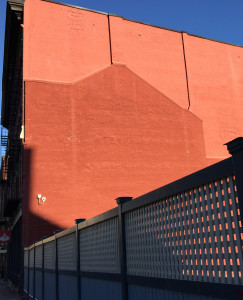The Missing Tooth, Merrimack Street
From Amy Bisson . . .
This is the part of Merrimack Street, referred to by some as the “Missing Tooth”. The outline of what used to be fairly glows on the wall of the adjacent building, and while the fence facing Merrimack Street does a decent job of hiding the parking lot located behind, lack of a building or something more purposeful does seem to impact the streetscape of this section of Merrimack. Jeff Speck targeted this lot for improvement in the Lowell Plan Report (Link here and then see Section 9.1, Page 85).

Excellent commentary. The downtown evolution plan is our “road map” to success.
Ha, did not know this was called Missing Tooth. So good.
My favorite part of that lot is the view it gives of the next street over. I will always wonder why there is a super narrow tower in that alley by Rogers. https://instagram.com/p/37mLBEBfRI/
This parting wall was a dividing partition between two adjoining buildings. It traces the outline of an earlier 1830s building that was lost in a fire in 1904 and replaced by a structure known as the Bascom Block that was as tall as the adjoining Albion Block. Unfortunately the Bascom itself was also lost in a fire in the early 1990s, revealing the older parting wall silhouette. A lone cast iron storefront pier also remains from the Bascom along the right edge of the Albion block, an echo in much the same manner as the earlier 1830s parting wall.
Architectural remnants such as these provide interpretive moments and opportunities in the downtown and National Park areas. They are similar to other newer architectural and archeological interpretations one can find in several landscapes including behind the Tsongas Center, the park at Lawrence Mills, and the courtyard of Appleton Mills where former buildings and other subsurface features are traced in granite, brick, or stone to recall what was once there (surviving remnants are also sometimes included in the landscapes as well). The modern landscapes become more meaningful and respond to the contexts in which they’re designed for, driven by the historic development and archeology of a particular site, linking them with the past.
Other similar examples can be found in the granite tracery that outlines the long-gone Huntington Hall within the Lowell Heritage State Park plaza areas on Shattuck Street, along with the historic brick vault and recreated building arches, as well as in many places along the National Park Canalway path system where train rails are often embedded in the path to indicate where rail lines once passed or in the reconstructed smokestack base at Swamp Locks where a much taller stack once stood for the Lowell Machine Shop. Lots of discoveries out there, both large and small to be made!